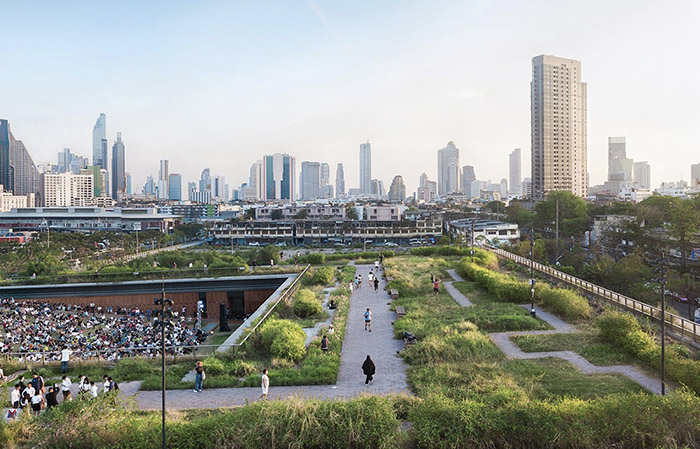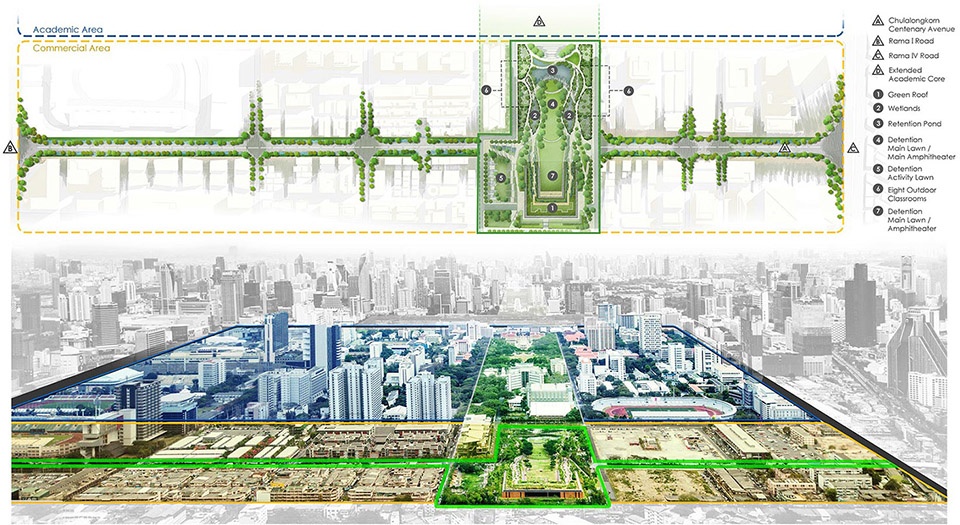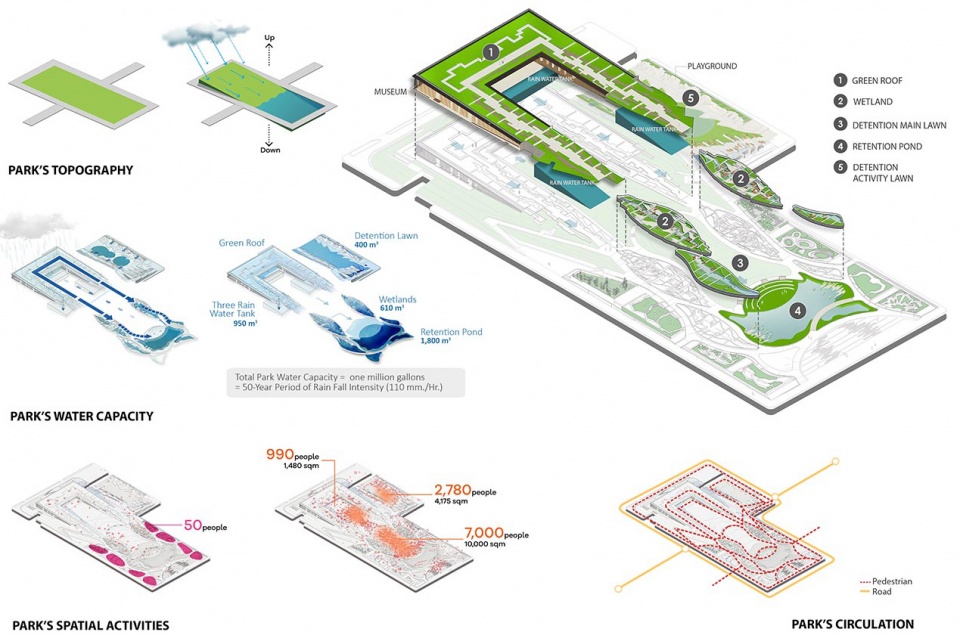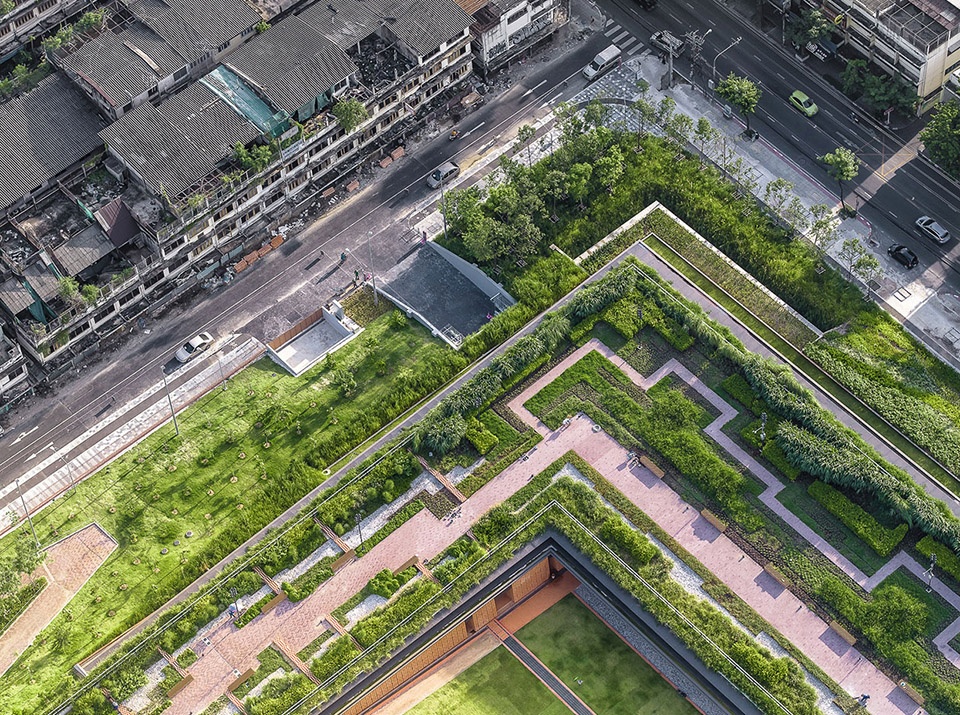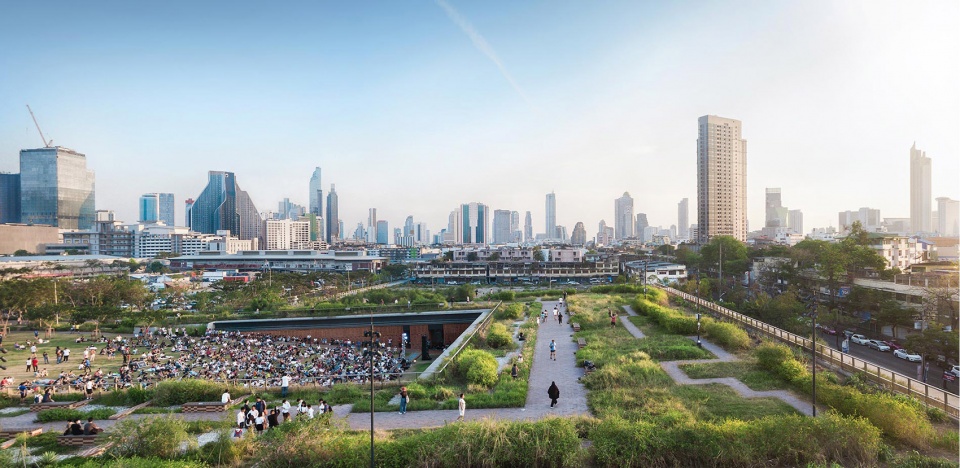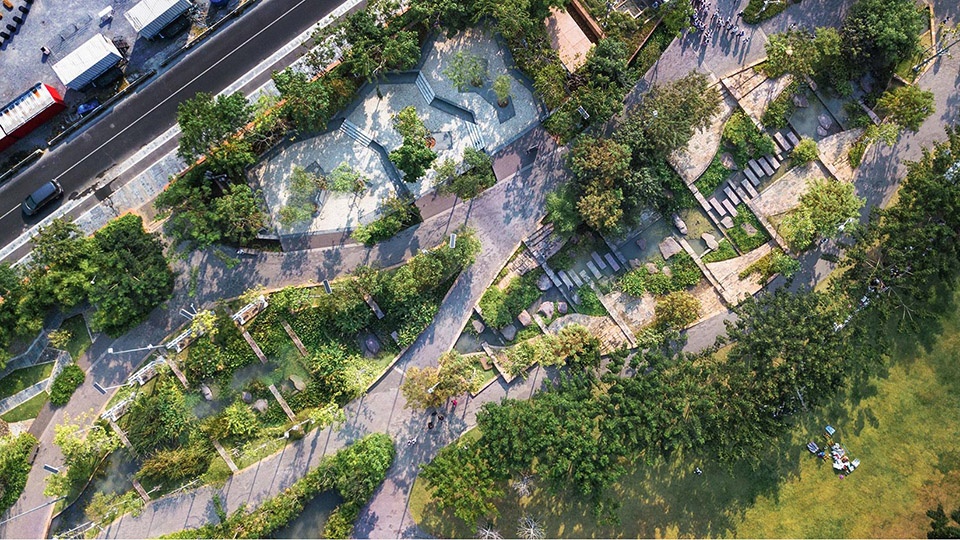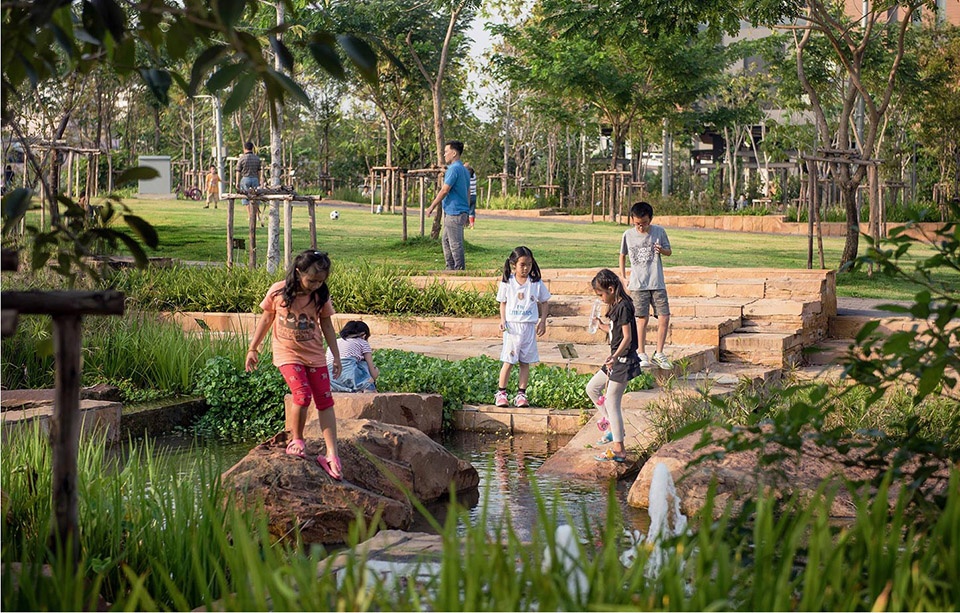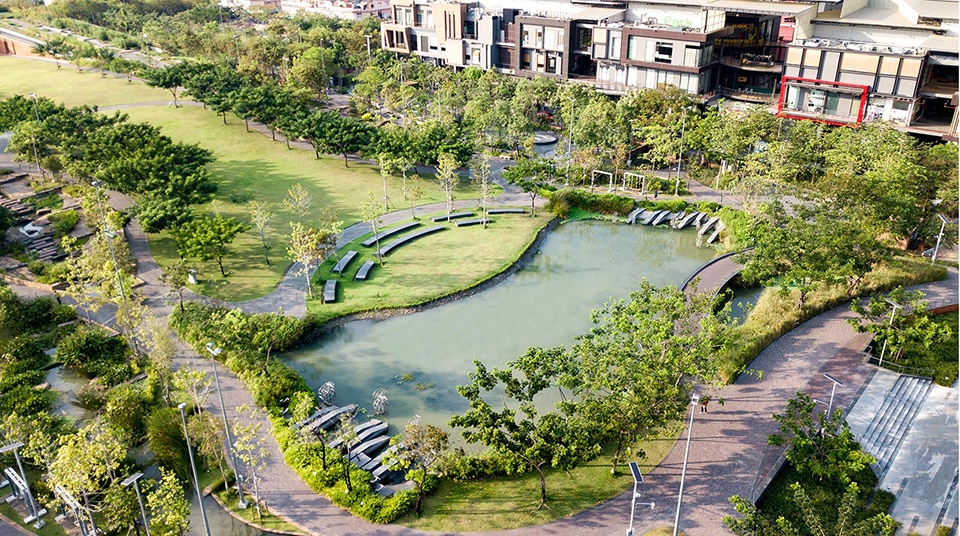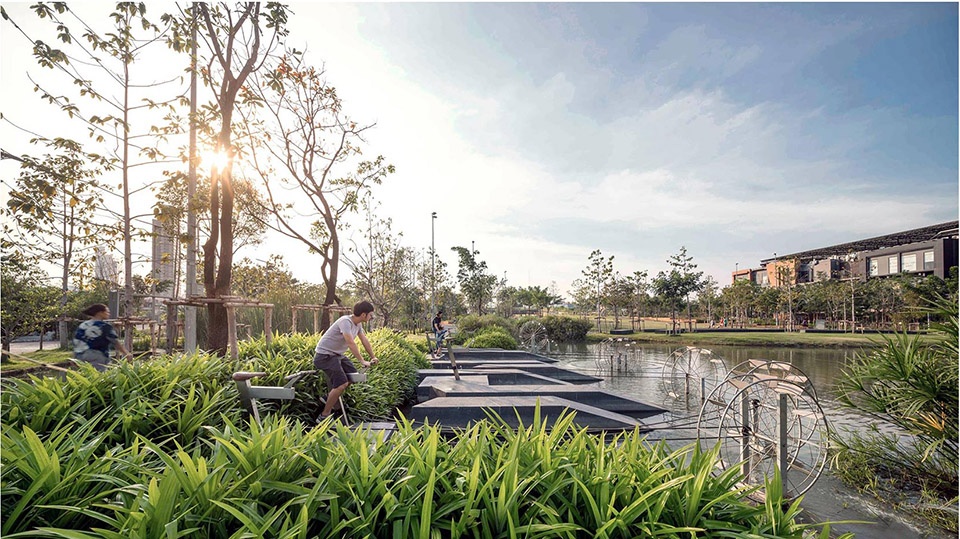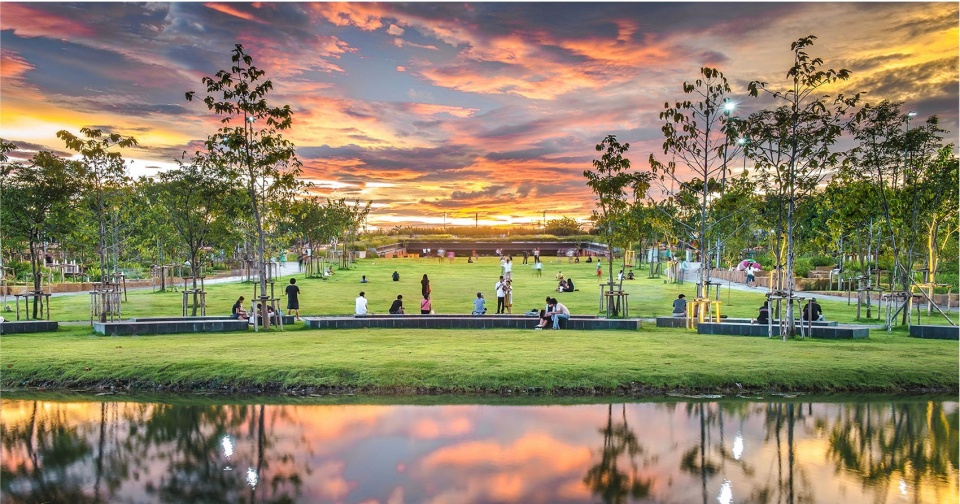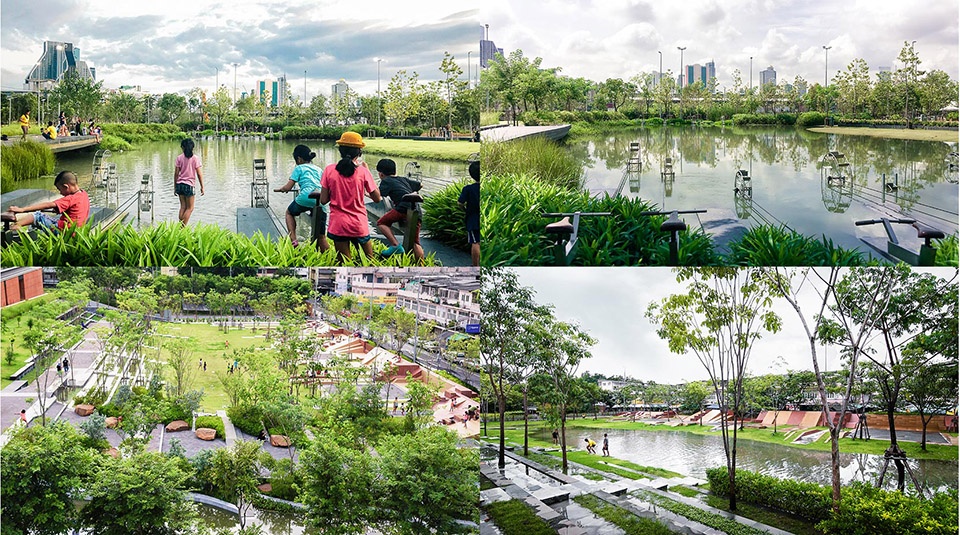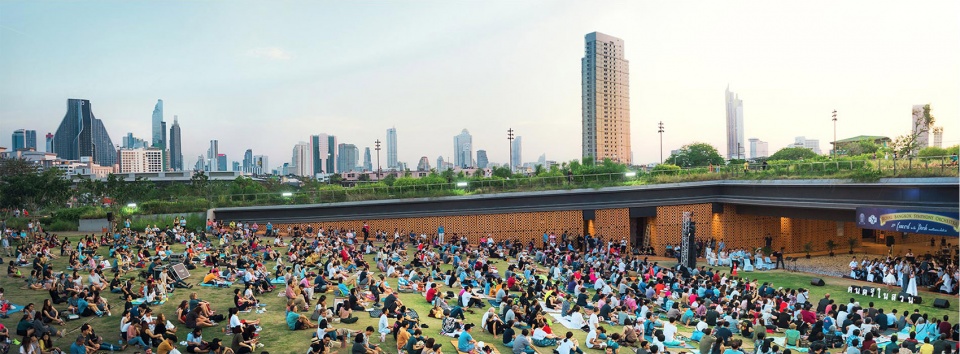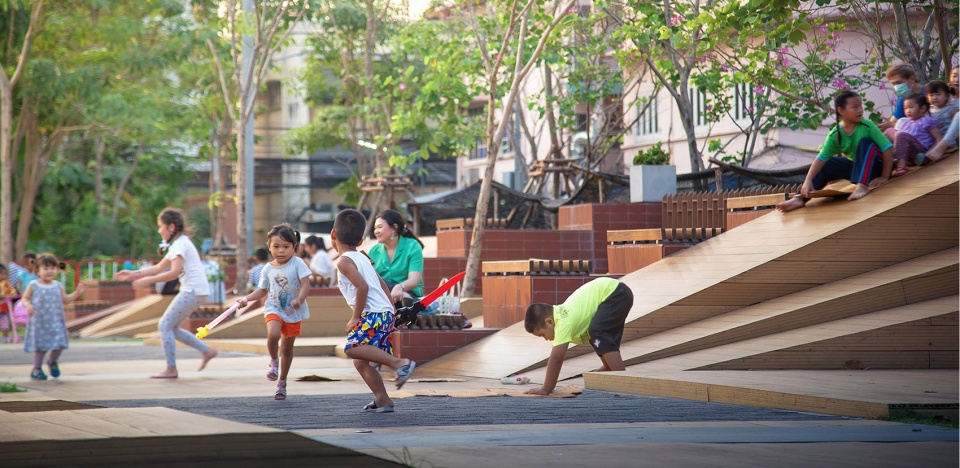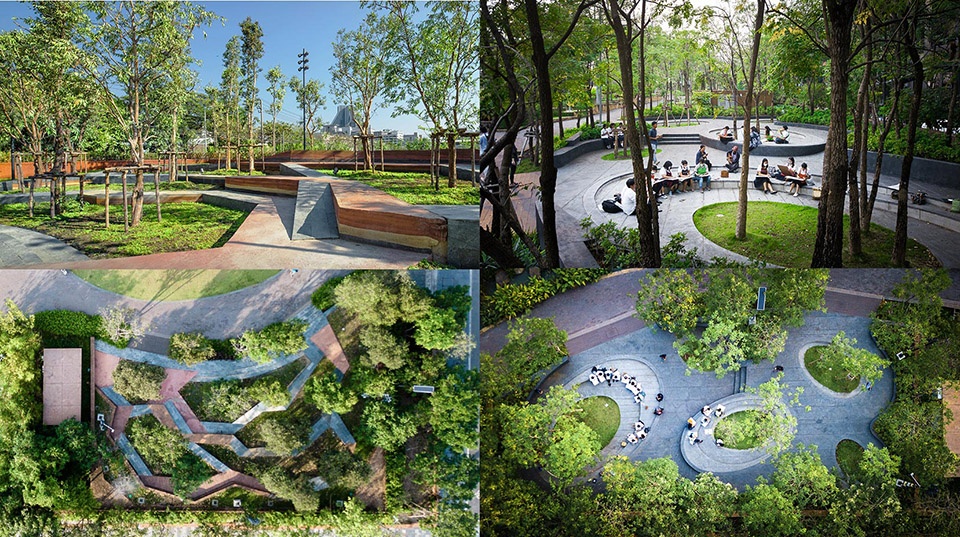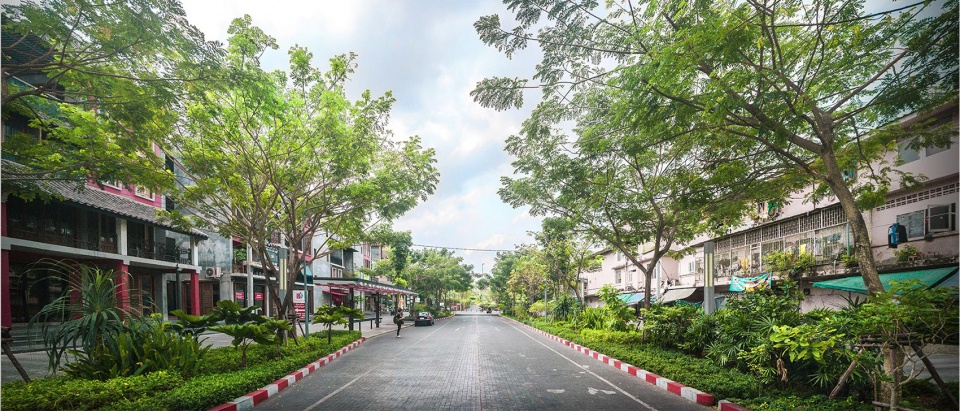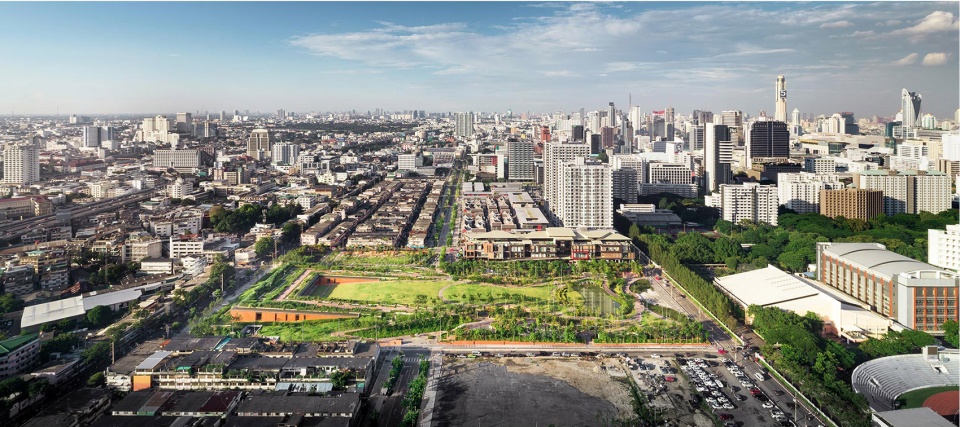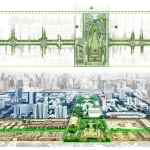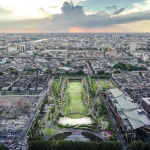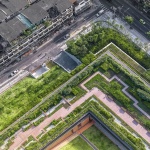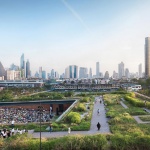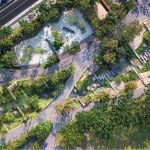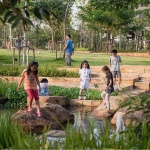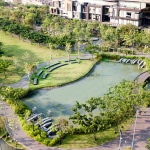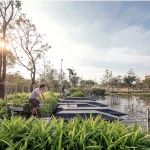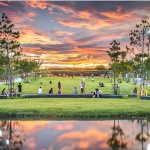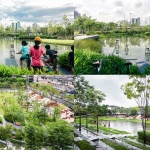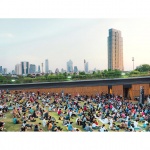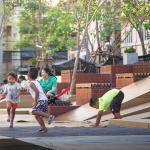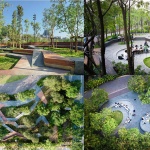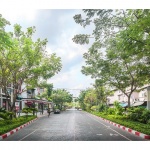“在曼谷持续30年的迅速发展下,这片价值极高的土地并没有像其他区域那样成为商业街区,相反,它被设计为一个规模巨大的公园,成为曼谷最重要的绿色基础设施。设计的目的不仅在于美化环境和提供活跃的公共空间,还在于为面临严峻环境挑战的区域完成一系列复杂的防洪和气候调节工作。这座占地11英亩的公园包含了湿地、拦洪草坪、蓄水池以及泰国最大的绿色屋顶,并将游乐场、露天剧场、花园和冥想空间等设施融入动态的公共环境。大胆的概念与亲切的体验在项目中取得了平衡,向人们证明了城市无需惧怕于水,而是可以与之共存。”
– 2019年评审委员会“For the first time in 30 years of rapid development, an enormously valuable property in the heart of Bangkok was not turned into another block for commercialuse. Instead, it was designed as a vast public park that is the epitome of green infrastructure. Designed for beauty and active public use, it also does the complex work of mitigating urban flooding and responding to climate change in a region that faces severe environmental challenges. The 11-acre park includes wetlands, detention lawns, a retention pond, and the biggest green roof in Thailand, all integrated into dynamic public spaces where people can enjoy playgrounds, an amphitheater, gardens, and meditation areas. Bold concepts strike a balance with small, intimate moments, reminding the world that landscape architecture can help a city under threat learn to live with water, rather than fear it.”
– 2019 Awards Jury
来自 ASLA 对gooood的分享。
Chulalongkorn University Centenary Park | LANDPROCESS
项目概述
PROJECT STATEMENT
当下,持续变化的气候导致了海平面上升、风暴潮和突发性暴雨等一系列问题,全世界地势较低的城市都不得不为防止洪涝灾害做准备。曼谷也是这些城市中的一员:海平面上升和混凝土设施的成倍增加造成其每年下沉两厘米的局面。
朱拉隆功百年纪念公园位于曼谷市中心,其所在场地坐拥11英亩的土地和1.3公里长的道路。在曼谷持续30年的迅速发展下,这里并没有像其他区域那样成为一个商业街区,相反,在2017年开放以来,公园成为了曼谷最重要的绿色基础设施,有效地缓解了生态问题,降低了灾害的风险。与城市周围的其他公园有所不同,朱拉隆功百年纪念公园第一次证明了公园在减少城市洪水和应对气候变化方面的重要作用,同时为城市居民提供了与自然重新接触的机会。通过创新性的生态设计,朱拉隆功百年纪念公园向人们证明,城市无需惧怕于水,而是可以与之共存。
Today, as our constantly-fluctuating climate causes rising sea levels, storm surges, and unexpectedly heavy rainfall, low-lying cities across the globe are bracing for urban flooding disaster. As sea levels rise and concrete infrastructure multiplies, Bangkok is sinking two centimeters every year.
For the first time in 30 years of rapid urban development, an invaluable property at the heart of Bangkok—11 acres of land and 1.3 kilometers of the road— was not turned into another block for commercial use. Instead, it is transformed into a public park for people. Opened in 2017, Chulalongkorn Centenary Park is the first critical piece of green infrastructure in Bangkok to mitigate detrimental ecological issues and reduce disaster risk. Unlike other public parks around the city, this is the first in Thailand to demonstrate how a park can help the city reduces urban flooding and confronts climate change, all while offering city dwellers a place to reconnect with nature. Designed with innovative ecological design components, the park reminds the city how to live with water, rather than fear it.
▲场地和环境:朱拉隆功大学是泰国的第一所大学,在其成立100周年之际,学校提出为曼谷建造一个新的公园。该项目占地11英亩,从校园的核心地带一直延伸到城市中心,并有一条1.3公里长的道路贯穿其中。The site and context: Chulalongkorn University, Thailand’s first university, celebrated its 100th anniversary by giving Bangkok a new public park with an 11-acre plot of land and 1.3-km. avenue extending from its core campus at the heart of the city.
项目说明
PROJECT NARRATIVE
下沉中的城市:如今的新常态
曼谷位于湄南河的泛滥平原地带,与河水形成相互依存的共生关系。如今,盲目的城市扩张导致了地下水的过度使用以及高楼大厦对地面的沉重压迫。爆炸式的发展忽略了城市的三角洲景观和其渗透性,破坏了天然的水道和能够吸水的农田。整个城市在降雨后30分钟便会被淹没:到2030年,城市中的数个主要区域及其周边区域都将被水淹没。曼谷是全球公共绿化比例最低的首都之一(仅3平方米/人,平均值为9平方米/人),因此正面临着不可避免的气候变化问题。
曼谷未来的绿色模式
朱拉隆功百年纪念公园所在的场地坐拥11英亩的土地和1.3公里长的道路,是曼谷商业中心的一块价值7亿美元的昂贵区域。尤其宝贵的是,在曼谷持续30年的迅速发展下,这里并未被改造成购物商场或办公楼,而是成为了一个绿色的公园。2012年,朱拉隆功大学发起了公园的设计竞赛,旨在于学校成立100周年(2017年)前夕将校园的绿地奉献给大众以示其对社会的回馈。
考虑到气候变化加剧了城市和未来几年的干旱和极端降雨问题,设计团队设想了一系列未来可能遇到的挑战:100年后的曼谷将面临什么?新建的公园如何能够在传承大学传统的同时,继续保持其百年来在泰国的开创性地位?
设计团队认为,新公园的作用不仅仅是美化环境或提供休闲设施。他们意识到曼谷不仅亟待增加绿色空间,还需要通过更加弹性化的景观设计来应对气候变化和极端降水的挑战。
在长达五年的设计和推进过程中,设计团队与各方委员、学生和利益相关者进行了社区导向的讨论和协作,最终为公园制定出了合适的功能计划,同时确保公园能够达到缓解城市气候变化的目的。在同时满足社会和环境需求的基础上,朱拉隆功百年纪念公园于2017年正式向公众开放。
为洪水多发城市建造的防洪公园
曼谷是一个地势平坦的城市。在地心引力的作用下,公园得以持续地收集、处理并存蓄雨水,从而降低周边地区的洪水风险。呈3度倾斜的场地容纳了多种生态功能:从最高处的绿色屋顶、湿地、拦洪草坪到最低处的蓄水池,确保每一滴水都不被浪费。雨水和径流顺应公园的地形一路向下,形成一个完整的水循环系统。设计将50年一遇的降雨强度和超负荷状态下的公共污水处理系统纳入考量,能够在暴雨期间承受100万加仑的水量。
站在公园的最高点,所有人都可以欣赏到曼谷天际线的壮观景象——这里不是昂贵的屋顶酒吧,也不是摩天大楼宽阔的停机坪,而是全泰国最大的、占地5200平方米的绿色屋顶,开阔的天空和碧绿的草地,一切都可以免费地享受。屋顶上种植着易于维护的杂草和原生植物,为鸟类和昆虫提供了栖息地,在高密度的城市中营造出独一无二的自然体验。绿色屋顶下方是博物馆和停车场空间。此外还有三个位于地下的蓄水箱用于储存从屋顶吸收的雨水,在旱季时能够为公园提供一个月的灌溉量。
从绿色屋顶排出的多余径流将被输送至四个重新建造的湿地,分别位于公园的两侧。一系列落水台和池塘减缓了径流的速度,增加了水流的送氧量,并通过本土水生植物来辅助水的过滤和清洁。在混凝土建筑林立的城市中,公园成为了一个隐秘的绿洲,不论大人还是小孩,都可以在这里尽情探索、与湿地互动,聆听悦耳的水声。
位于公园中心的主草坪是一个广阔、倾斜而开放的休闲空间。与市内其他平坦的公园不同,倾斜的场地形成了独特的多功能露天剧场,为公众带来有趣的活动场地。在暴雨期间,草坪可以吸收雨水和径流,并借助重力将水输送到低处的蓄水池。如果遇到严重的洪涝灾害,蓄水池可以将过量的水储存起来并向公园的主草坪扩展,从而增加一倍的面积。游客本身也成为水处理系统中的一环:池塘边设有固定的水上自行车,人们在玩乐的同时就可以为水注入氧气。
可持续的排水系统、绿色屋顶、湿地、渗透区域、池塘、开放沼泽、小型口袋公园、拦洪草坪和蓄水池等一系列景观解决方案使公园成为了具有开创性的能够减少城市洪涝灾害的公共空间。曼谷亟需建造更多的公园,但更重要的是建造能够持续应对气候变化问题的具有生产力的公园。朱拉隆功百年纪念公园通过发挥景观设计的潜力,证明了城市无需惧怕于水,而是可以与之共存。
在应对气候风险的同时,公园还为大学社区、附近的街区以及城市居民提供了休闲空间和户外教学空间。与主草坪相连的8个“户外景观教室”容纳了不同类型的生物群落,在公园的两侧创造出多样化的功能区域。这些“教室”包括草药园、冥想区、阅读室、竹园、游乐场和露天剧场,在构件和材料的选择上都经过了谨慎挑选,为公园主要的生态景观提供了最适宜的补充。
随着雨季旱季的交替,公园的植物和水景也会发生相应的改变,为游客带来新的环境体验。本着构建城市森林的理念,公园中的285种植物将从种子或幼苗时期开始种植,以更好地适应气候变化,重建健康的生态系统,为当地鸟类、传粉生物和昆虫提供栖息地。
第一条为民众而建的绿色大道
一条1.3公里长的道路垂直地贯穿了公园场地,经过重新设计之后,原先汽车的主导地位被行人和自行车取代。既有的四条车道被减至两条,作为步行和骑行的空间。原本非常拥挤的街道如今为路人和骑行者提供了直接通向附近住宅、娱乐和商业设施的路径。公园的两侧分布着雨水花园走廊,带来阴凉舒适的空间,同时减少了与之相邻的路面的径流。该设计向曼谷证明了商业开发区完全可以兼备行人友好的特征。
气候变化在几十年来都是一个严峻的问题,但我们无疑正在迈入一个可持续发展和具有恢复能力的时代。仅靠一个公园虽然无法解决整个城市的洪水问题,但朱拉隆功百年纪念公园的出现标志着我们向这一目标跨出的大胆一步。城市发展是不可避免的,人口的增加亦是如此,但景观设计师有义务去考虑一切可行的解决方案,为我们的未来找到希望。朱拉隆功百年纪念公园为曼谷擦出了一朵愿望的火花,它启发着这座城市去思考如何应对未来可能的威胁,同时让新的景观设计策略得以出现。
▲公园的生态功能和社会功能:公园的地势呈3度倾斜,能够充分收集雨水,存储量高达100万加仑。公园的设计以应对50年一遇的降水强度为考量,旨在同时在社会和生态方面产生影响。Park ‘s ecological function and park’s social function: With its 3-degree incline, the park collects every drop of rain and holds up to a million gallons, taking into account a 50-year return period of precipitation intensity to address both the park’s social use and ecological impact.
▲曼谷,下沉中的城市:上升的海平面和迅速增加的混凝土基础设施侵蚀着曼谷的天然水道和农田,让本身处于低洼地带的城市每年下沉2厘米之多。通过重建具有渗透性的地表,新公园能够帮助城市可持续地解决积水问题。Bangkok, the sinking city: Rising sea levels and rapidly multiplying concrete infrastructure erodes former natural waterways and agricultural land in Bangkok, sinking this low-lying city by 2 cm yearly. The park helps the city sustainably address water issues by reclaiming its porous surface.
▲泰国最大的绿色屋顶:公园的最高点设有全泰国最大的绿色屋顶,占地5200平方米。倾斜的屋顶能够吸收雨水和径流,并将其引向三个地下水箱、湿地以及公园低处的蓄水池。The biggest green roof in Thailand: At the park’s highest point is the biggest green roof in Thailand covering 5,200 Sq. m. The inclined green roof absorbs and gravitates rain and runoff toward three underground tanks, wetlands and a retention pond at the park’s lower end.
▲向天空敞开的绿色屋顶:与城市中平坦的公园有所不同,该公园的绿色屋顶提供了独特的天际线景观。杂草和原生植物在高密度的城市中营造出乡野般的自然体验。Bangkok open sky on top of the green roof: Unlike in other flat parks around the city, the park’s green roof offers a unique elevated view of Bangkok’s skyline, propped up in a rural and natural environment of native grass and local wildlife.
▲层叠的湿地:从绿色屋顶排出的多余径流将被输送至四个重新建造的湿地。一系列落水台和池塘减缓了径流的速度,增加了水流的送氧量,并通过本土水生植物来辅助水的过滤和清洁。Cascading wetlands: Excessive runoff from the green roof flows through to four constructed wetlands, a series of cascading weirs and ponds, collect, slow down runoff and increase water aeration aided by native water plants which help filter and clean the water.
▲属于鸟儿、昆虫和孩子们的秘密绿洲:在混凝土建筑林立的城市中,公园成为了一个隐秘的绿洲,不论大人还是小孩,都可以在这里尽情探索,聆听悦耳的水声,与流水、树木、植物、鸟儿和昆虫愉快地互动。Hidden oasis for kids, birds and insects: In a concrete city like Bangkok, the park ’s wetlands provide a hidden oasis where kids and adults can explore and interact with nature- water, trees, native plants, bird and insects, and hear the sound of flowing water-once again.
▲蓄水池:借助重力作用,公园最低处的蓄水池能够将每一滴水收集起来。在洪水期间,蓄水池的面积几乎可以扩大一倍,一直延伸到公园倾斜的草坪上。The retention pond: Harnessing the power of gravity, the retention pond at the park’s lower end collects every drop of water. During heavy floods, the pond can almost double in size by overflowing onto the park’s inclined lawn.
▲一起行动,助力城市水清洁:池塘边设有固定的水上自行车,游客们可以在玩乐的同时为水注入氧气,帮助完成水的清洁,从而成为公园水处理系统中的积极一环。Let’s help clean up the city ‘s water: Visitors can become an active part of the park’s water treatment system by hopping on to stationary water bikes along the pond, using their exercise as a fun and active way to help aerate and clean water.
▲拦洪草坪:公园的主草坪是一个宽广的开放空间,能够为各种活动提供灵活的空间,其中包括与朱拉隆功大学核心校园主轴线平齐的露天剧场。The detention main lawn: The park’s main lawn is a vast open space to maximize flexibility for multiple purposes, including serving as an amphitheater in alignment with the main axis of Chulalongkorn University’s core campus.
▲泛洪期间的公园:2017年,持续六小时的降雨淹没了整个曼谷市区。在这种情况下,具有高度适应性的防洪公园能够作为滞洪区来缓解洪水对其周围街区的影响。When it is flooded: In 2017, six hours of rainfall flooded the entire city of Bangkok. In such situations, this highly-adaptive flood-proof park will serve as a detention area, reducing the urban flood impact on its surrounding neighborhood.
▲城市里的第一个新公园露天剧场:公园的坡度不仅能够起到输送径流的作用,还为市民们提供了曼谷第一个城市尺度的露天剧场。倾斜的草坪周围环绕着建筑物,为音乐节等活动提供了理想的声学效果。The first new park’s amphitheater in town: Park’s slope is not only design for gravitate runoff, yet, offers urbanists the first urban-scale outdoor amphitheater in all of Bangkok. This inclined lawn framed by park’s architecture, which provides optimal acoustics for music festivals and events.
▲备受欢迎的滑梯游乐场:公园的外侧是维护结构,内侧则形成一个包含滑梯和休闲区的游戏场地,可供孩子们在这里安全地玩耍,同时也为社区提供了氛围轻松的休闲空间。Favorite slides playground: On outer side, the structure serves as fence, on the park ’s side, it serves as a local playground, disguising as slides and recreational area both for children to safely play among friends and for community in relax atmosphere.
▲户外景观教室:主草坪旁边设有8个“户外景观教室”,各自容纳了不同类型的生物群落,为大学社区和附近的街区创造出多样化的功能区域,激发了公园边界的活跃氛围。Outdoor landscape classrooms: Adjacent to the main lawn are eight “landscape outdoor rooms,” each designed with different biomes and layouts, which serve as multi-purpose areas for university communities and neighborhoods and stimulate movements and activities along the edge of the park.
▲经过重新设计之后,公园中既有的四条车道被减至两条,其宽度由12米扩大到30米。曾经拥堵严重的道路成为以行人和自行车为优先的空间,将步行者和骑行者与周围的环境无缝地衔接起来。Prioritize the pedestrians and cyclists: By reducing four vehicle lanes into two and enlarging the road section from 12 to 30 meters, the once heavily-congested street shifts priority from cars over to pedestrians and bicycles and seamlessly connects pedestrians and cyclists to their surroundings.
▲为下沉中的城市提供景观解决方案:仅靠一个公园虽然无法解决整个城市的洪水问题,但它标志着我们向这一目标迈出的第一步。景观设计师有义务去考虑一切可行的解决方案,以拯救我们正在下沉中的城市。Landscape architecture solution for sinking city: A single park cannot control urban flooding across an entire city, but this is the first step. As landscape architects, it is our obligation to consider every possible solution and sign of hope to save our sinking city.
PROJECT NARRATIVE
SINKING CITIES: OUR NEW NORMAL
Sitting on the floodplains of the Chao Phraya River, Bangkok has always lived with water in an interdependent amphibious relationship. Today, urban sprawl has gone unchecked, underground water is used excessively, and weight from high-rise buildings is increasing rapidly. Explosive development ignores the city’s delta landscape and its porosity while eating away natural waterways and agricultural land that once absorbed water. The entire city can be flooded within just 30 minutes of rainfall: by 2030, it could submerge many major areas in the city and surrounding areas. Bangkok is a capital city with one of the lowest ratios of public green space of just 3 Sq.m, compared to the average of 9 Sq.m per person. The city is now facing an inevitable reality of climate change.
A GREEN MODEL FOR BANGKOK’S FUTURE
For the first time in 30 years, a priceless plot at the center of Bangkok’s commercial district—11 acres of land with a 1.3-kilometer stretch of road worth US$700 million—was not turned into a shopping mall or office building. Instead, it was transformed into a public park. For its 100th anniversary, Thailand’s very first university, Chulalongkorn University, wanted to give back to society by offering property extending from its core campus for a new public park as part of a 2012 design competition.
As climate change exacerbates both drought and extreme rainfall in the city and in the years to come, the design team posed questions envisioning challenges of the future: What will Bangkok confront 100 years from now? How can this park carry on the university’s legacy and role as a pioneer in Thailand, as has been the case over the past century?
The designer concluded that this park’s vision could not be merely beautification or recreation. The team realized that Bangkok needs not only more green space but more resilient landscaping to tackle climate change and its water challenges.
After five years of numerous meetings, building upon a community-oriented design process with committees, students and surrounding stakeholders, the designers were able to develop an activity program for the park, while ensuring its purpose in mitigating urban climate change. Fulfilling both the social and environmental impacts it needed to address, the Chulalongkorn Centenary Park was launched in 2017.
A FLOOD-PROOF PARK FOR A FLOOD-PRONE CITY
Bangkok is a flat city. By harnessing the power of gravity, The park is able to sustainably collect, treat, and hold water to reduce urban flood risks in its surrounding areas. Sitting on a three-degree angle, the park is equipped with several ecological features, from its highest point, — green roof, wetlands, detention lawns, to its lowest point, retention pond — leaving not a single drop of rain wasted. The rain and runoff are pulled down through the park’s topography to generate a complete water circulation system. Taking into account a 50-year period of rainfall intensity and the frequently overwhelmed public sewage system, the park is able to hold up to a million gallons of water during heavy rainfall.
At the park’s highest point, any member of the public can see Bangkok’s skyline—not on an expensive rooftop bar or a skyscraper helipad, but atop the biggest green roof in Thailand covering 5,200 square meters where open skies and green grass are free to all. Laid with low-maintenance native grass and weeds which attract local birds and insects, the roof provides a unique experience of a rural and natural environment with a dense urban backdrop.
Underneath the green roof lies a museum and parking space, made possible by the inclined architecture. Additionally, three underground tanks store rainwater absorbed from the green roof. The amount of water held can irrigate the park for up to a month during dry seasons.
Excessive runoff from the green roof then flows down to four constructed wetlands, two on each side of the park. A series of cascading weirs and ponds slow the runoff and increase water aeration, aided by native water plants that filter and clean the water. In the concrete city of Bangkok, the park provides a hidden oasis where kids and adults can explore and interact with wetlands and hear the sound of flowing water.
The main lawn at the park’s center is a vast inclined open space for recreational activities. Unlike other flat parks around the city, this inclined park offers the unique experience of multi-purpose amphitheater for public events. On stormy days, the lawn absorbs rain and runoff, using gravity to send the water to the retention pond by the low end of the park. During severe flooding, this retention pond can store excessive water and double in size by expanding into the park’s main lawn. Visitors, too, can become an active part of the park’s water treatment system by hopping onto any stationary water bikes along the pond and using their exercise to keep the water aerated.
Featuring sustainable drainage systems, a green roof, wetlands, porous areas, ponds, an open swale, small pocket parks, detention lawns, and a retention pond, the park is a premiere example of various landscape solutions for urban flood disaster reduction. Bangkok desperately needs more parks, but more importantly, productive ones that can sustainably confront climate uncertainty. By demonstrating the potential of landscape architecture, Chulalongkorn Centenary Park shows the city ways to live with water, rather than fear it.
While playing a role in confronting climate risk, the park simultaneously serves as a recreational space and outdoor classroom for the university community, surrounding neighborhoods and urban dwellers. Adjacent to the main lawn are eight “landscape outdoor classrooms,” each with different biomes and layouts, lining both sides of the park to serve as diverse multi-purpose areas. They include an herb garden, meditation area, reading room, bamboo garden, playgrounds, and earthen amphitheater. Whether in the choice of porous components or locally-sourced materials, these outdoor classrooms incorporate details to best complement the park’s main ecological features.
As Bangkok experiences droughts and monsoons, the park’s water and landscape will continually grow and transform to unveil new environments for visitors to experience. Following the planting concept of establishing urban forests, 258 varieties of plants and trees have been grown either from seed or as young seedlings which easily adapt to climate changes, recreate a healthy ecosystem, and provide habitat for local birds, pollinators, and insects.
THE FIRST GREEN AVENUE MADE FOR THE PEOPLE
The first of its kind in Bangkok, the 1.3-kilometer road running perpendicular to the park was redesigned to shift priority from cars to pedestrians and cyclists. By reducing four vehicle lanes into two, providing space for people walking and biking, the once heavily-congested street now seamlessly connects pedestrians and cyclists directly to surrounding neighborhoods’ residential, entertainment, and retail facilities. The park is lined with corridors of rain gardens on both sides to provide shade and human comfort, and reduce runoff from the adjacent road surface. This design is evidence to Bangkok the possibility of a commercially-developed area that is, finally, pedestrian-friendly.
While climate change has been a prominent issue for decades, we are undoubtedly moving towards an age of sustainability and resiliency. A single park cannot control flooding across an entire city, but Chulalongkorn Centenary Park is a big, bold first step. Urban development is inevitable and the population is bound to rise, but it is our obligation as landscape architects to consider every possible solution and sign of hope for our future. The Chulalongkorn Centenary Park gives Bangkok a spark of aspiration in how the city can choose to address its threatened future while allowing new landscape architecture strategies to emerge.
More:ASLA; LANDPROCESS
